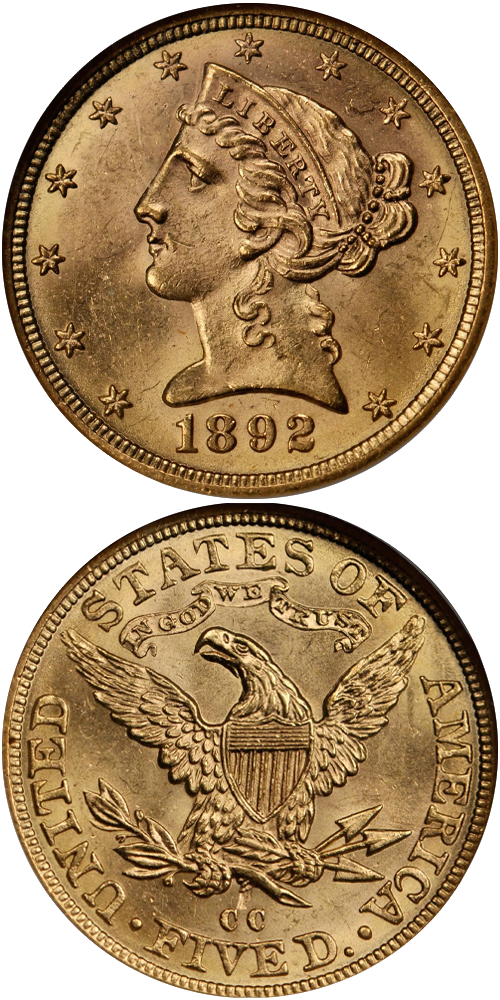1892-CC Liberty Head Half Eagle
Jeff Ambio: The only known die marriage of this issue has the date placed high in the field and off center toward the viewer's left. The mintmark is of medium height with the individual letters fairly widely spaced. The first C is above the left side of the letter V in FIVE and the second C is above the left side of the letter E. In this earliest state of the dies the mintmark shows no signs of machine doubling and the scroll is intact under the word WE in the motto IN GOD WE TRUST.
Rusty Goe: Gold and its movements across the nation and across oceans continued to stimulate discussion in Congress, the Treasury Department, and the White House in 1892. Simultaneously, and directly influenced by gold's status, the free coinage of silver debate raged in political campaigns in the presidential election year.
Mint Director Edward O. Leech, in his 1892 annual report, reiterated how "the most serious loss of gold which this country has sustained for many years," had occurred in 1891, and how "the total amount exported [to Europe] was [over $70 million]," during a six-month period that year. Another "great cause of continued large shipments of gold," according to Leech was "the distrust of United States securities ... in the minds of European investors" because of the excess supplies of silver coins (dollars) held in reserve "for the redemption of our paper currency." The free coinage of silver movement further incited the fears of foreign countries, who saw it as a threat that could force the United States back onto a bimetallic standard which, in the minds of many international economists, could cause a global economic panic.
Meanwhile, the Treasury, in an attempt to balance the export-import flow of gold coins, again calibrated its apportionments of the three main denominations. Double eagle production declined 26 percent in 1892 from the previous year's output, while the mintages of eagles quintupled and half eagles increased four and a quarter times.
The Nevada coin factory ended the year by tallying the second highest annual output of half eagles in that institution's history. Carson City Coiner Charles Colburn delivered 82,968 of the Carson City half eagles in 1892, and approximately one and a half percent survive today. The one example that towers above all others in terms of quality once belonged to Louis E. Eliasberg Sr., the most prominent coin collector in U.S. history. Numismatic Guaranty Corporation awarded that piece an MS-66 grade.
Q. David Bowers: I estimate that 500 or so 1892-CC half eagles exist in circulated grades, mostly EF and AU, and somewhat over 100 Mint State. Again, Jim Kelly's agent found many of these in Europe starting in the 1950s. Prior to that time the 1892-CC was a rarity in Mint State.
The coin cited below was considered a rarity when it was auctioned in 1955. I was in the audience and remember the event well:
The example to the left was sold by Stack's Bowers Galleries in the August 2012 Battle Born Collection of Carson City Coinage, where it realized $28,200.






